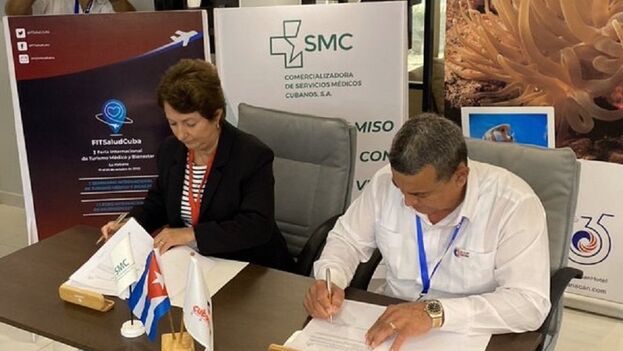
![]() 14ymedio, Havana, 13 October 2022 — “A well-oiled infrastructure,” is how Prensa Latina describes the work of the Marketing of Cuban Medical Services (CSM), protagonist of the First Medical Tourism and Welfare Fair that will be held at the Pabexpo venue, from October 17 to 21, in Havana.
14ymedio, Havana, 13 October 2022 — “A well-oiled infrastructure,” is how Prensa Latina describes the work of the Marketing of Cuban Medical Services (CSM), protagonist of the First Medical Tourism and Welfare Fair that will be held at the Pabexpo venue, from October 17 to 21, in Havana.
The company is a health conglomerate that offers all kinds of services: assistance to foreigners (operations, treatments, therapies), training of students from other countries, and export of medical contingents.
In a post-pandemic global scenario, the CSM intends to launch an offensive to the international market by grouping the two most lucrative economic sectors of the Island: tourism and medical services. The goal is to offer an attractive “product portfolio” for tourists.
The First Medical Tourism and Welfare Fair will be part of the IV International Cuba-Health Convention 2022, which the Government will take advantage of to seduce the 1,500 foreign delegates with the CSM proposals.
Dr. Armando Garrido, director of Medicuba, explained that it was an expected moment “in which a group of actions will be realized: signing a significant number of contracts with international suppliers and letters of intent for new businesses.”
Since the last International Tourism Fair in May of this year, the CSM has achieved several contracts with the hotel companies that operate on the Island, so that vacationers could access dialysis services in Havana and Varadero and have “long-stay” plans in the Ciénaga de Zapata.
In this plan, the “immunization strategy” against COVID-19 through Cuban vaccines plays a fundamental role, “among many other benefits of this type,” says Prensa Latina. The official agency doesn’t clarify, however, that most countries have already vaccinated the population free of charge, so traveling to Cuba to immunize is, at the very least, unnecessary.
The official agency interviewed economist Miguel Alejandro Figueras, who stated that “many tourists in the world wonder where they should go for a future vacation. Where will I find personal safety, health and humane treatment?” The answer, he said, “is Cuba.”
To support his opinion, Figueras added that health tourism is “a fast road to growth,” which contributed $2 billion to several countries. It’s the only way to achieve “the economic recovery of the nation.”
The tourist who intends to access Cuban medical services must fill out a form and present it upon entry into the country, along with his medical visa. One can also purchase a Tourist Card if the treatment will be carried out in less than thirty days.
The agency doesn’t accept payments in cash or dollars, but online or by bank transfer. The company itself processes the admission to hospitals and clinics, and if the treatment allows it, in the “hotel of your choice.”
If the patient wants a surgical intervention, he must remain for an indeterminate period of time in the country even if he is discharged. Also in that case, the CSM will be able to go to the hotel and care for the patient there, who will have options for the accommodation of relatives thanks to the company’s alliances with the hotel chains.
Those who wish to opt for a “comprehensive cancer treatment” can do so at the National Institute of Oncology and Radiobiology, which will include the use of the Cuban drug Heberferon, indicated for those who suffer from “basocellular carcinomas, in lesions of any size and location, including areas of high risk, the H area of the face, or in locally advanced areas that are difficult to treat due to proximity to the eyes or the brain.”
The CSM reminds its potential customers that the country is “a very safe destination” and recommends being treated in Havana, where “most of the medical tourism offer is located,” but customers can go to its premises in any province.
The so-called Wellness and Health Centers — for which the agency intends to attract foreign investment during the Fair — are located throughout the national territory. The San Vicente Thermal Centre, Pinar del Río, for example, is part of an old therapeutic bath inaugurated in 1901, with medicinal mineral waters that the CMS presents as “chosen by celebrities such as the novelist Ernest Hemingway” for relaxation.
Another thermal bath, located in Corralillo, Villa Clara, provides the same service of medicinal mud and “hyperthermal waters between 36 and 48 degrees Celsius.” It also mentions that the centre “has gained fame for achieving the healing of multiple circulatory, rheumatic, somatic, neurological and respiratory conditions, which don’t find a solution with other conventional treatments.”
In addition, in the hotel facilities that have signed contracts with the company, “bioenergetic, naturist, therapeutic-rehabilitating and aesthetic medicine will also be available.”
The countries that frequent Cuba as a tourist destination, such as Canada, have been the most enthusiastic investors in medical projects. The Canadian embassy in Havana notified on its Twitter account that $1.12 million in medical supplies would be delivered “to support the people of Cuba.” Other nations, such as Mexico, Japan and several members of the European Union have sent similar donations to the Island.
Translated by Regina Anavy
____________
COLLABORATE WITH OUR WORK: The 14ymedio team is committed to practicing serious journalism that reflects Cuba’s reality in all its depth. Thank you for joining us on this long journey. We invite you to continue supporting us by becoming a member of 14ymedio now. Together we can continue transforming journalism in Cuba.
